How to store, fold, and reuse shopping bags the simple and effective way
 By K-packing on Oct 19, 2025
By K-packing on Oct 19, 2025
Many people accumulate shopping bags at home, from plastic grocery bags to reusable totes, without realizing how much space they take up or how quickly they can become cluttered. Over time, these bags pile up in drawers, cars, and corners, making it harder to find or reuse them when needed.
This guide provides simple and effective methods to fold, store, and reuse shopping bags of all types. Each section offers practical steps to keep your bags organized, extend their lifespan, and make reuse effortless, whether you’re managing a few at home or hundreds in a business setting.
Let’s explore step by step how to turn messy piles of shopping bags into a neat, sustainable system that saves space, reduces waste, and supports your eco-friendly lifestyle.
See more: How to store, fold, and reuse shopping bags the simple and effective way
- How to fold shopping bags
Properly folding your shopping bags helps save space, keeps them tidy, and makes them easier to grab when needed. Whether you use plastic, canvas, or non-woven bags, the right folding method will help extend their lifespan and maintain a neat collection.
1.1 The triangle fold method
This classic technique works exceptionally well for thin plastic shopping bags and creates the most compact storage. It helps save space, keeps bags neatly organized, and makes them easy to grab on the go. However, it may not be suitable for thicker or rigid bags, as repeated folding can cause creases or shorten their lifespan:
Steps:
Flatten the bag completely – Lay it on a hard surface and smooth out any air bubbles.
Fold lengthwise – Fold the bag in half lengthwise two to three times until you have a narrow rectangular strip.
How to fold reusable shopping bags
Start the triangle – Take one bottom corner and fold it up to the top edge, forming a triangle.
How to fold reusable shopping bags
Continue folding – Keep folding the triangle upward, working your way along the strip.
Tuck the handles – Once you reach the top, tuck the handles into the final fold to secure it.
How to Fold Reusable Shopping Bags
This technique produces a compact, travel-friendly triangle that fits easily in your purse, glove compartment, or kitchen drawer.
1.2 Quick rectangle method
If you use shopping bags daily and need fast access, this is the simplest and most practical option.
Steps:
Fold lengthwise – Fold the bag in thirds along its length.
Fold toward handles – Starting from the bottom, fold upward toward the handles.
Wrap handles – Use the handles to secure the folded body in place.
This method works best when you frequently reuse the same few bags for groceries or errands.
1.3 For bulk quantities or retail operations
When handling large quantities of shopping bags – for example, in retail stores, fulfillment centers, or warehouse storage – it’s best to standardize your folding process.
Use folding templates or semi-automatic bag-folding equipment to save time and keep every fold uniform.
Bundle folded bags into sets of 10, 25, or 50 and secure them with paper straps or biodegradable ties for easy counting and distribution.
Store bundles in labeled bins or boxes according to bag type (HDPE, PP, rPET, cotton, etc.).
A consistent folding system not only keeps your stockroom organized but also improves operational efficiency and product presentation – especially when preparing reusable bags for retail display or shipment.
- How to organize shopping bags
Organizing your shopping bags properly helps you avoid clutter and ensures that every bag is easy to find when you need it. By sorting, categorizing, and assigning specific storage areas, you can maintain a clean, efficient system – whether you have a few reusable totes or hundreds of shopping bags collected over time.
2.1 Sort by type and category
Step 1: Separate by Material
Divide your bags into groups based on what they’re made of:
Plastic shopping bags
Paper bags
Canvas or cotton reusable bags
PP woven bags
Insulated cooler bags
Specialty or gift bags
Step 2: Assess Condition
Keep only bags that are clean and in good condition. Discard any that are torn, sticky, or damaged beyond reuse. You can also set aside bags that need washing or spot cleaning before storing them.
Step 3: Categorize by Use
Frequent use: Keep 3–5 bags easily accessible near your entryway or car.
Seasonal storage: Store holiday, travel, or event-specific bags separately.
Special purposes: Set aside bags for gifts, crafts, or errands.
Emergency backup: Keep a few folded bags in your car, purse, or office.
Sorting by purpose prevents over-accumulation and helps ensure every bag gets reused efficiently.
2.2 The “bag of bags” system
One of the easiest and most popular ways to organize shopping bags is the “bag of bags” method.
Choose one large, sturdy reusable bag as your main container. Fold and store all other bags inside it, then hang or place it near your door or pantry. When heading out shopping, you can simply grab the entire system – keeping things compact and easy to manage.
For smaller households, this method is ideal for keeping reusable and plastic bags in one place without creating clutter.
blank tote bags
2.3 For large inventories or business use
If you manage a store, office, or recycling collection point, it’s important to go beyond casual organization and establish a systematic bag management process.
Set up clearly labeled bins or shelving units for each bag material (HDPE, LDPE, PP, rPET, paper, fabric).
Create a log sheet or digital inventory to track how many bags are in stock, how many have been reused, and how many are sent for recycling.
Inspect stock monthly to remove worn or contaminated bags and prevent buildup.
For corporate sustainability programs, integrate QR or barcode tracking for reusable bags to measure actual reuse rates.
A structured organizational system like this saves time, reduces waste, and supports sustainability goals – especially in retail or logistics environments where thousands of bags circulate daily.
- How to store shopping bags
Once your shopping bags are properly folded and organized, the next step is storing them efficiently. Good storage not only saves space but also helps extend the life of your bags – keeping them clean, dry, and ready for reuse.
3.1 Space-saving storage solutions
- Tissue Box Dispensers
Use empty tissue boxes or small plastic containers as dispensers for thin plastic bags. Stuff folded bags inside and pull out one at a time. This method works great for kitchens, laundry rooms, or office pantries.
- Wall-Mounted Organizers
Install hooks, racks, or over-the-door organizers on the inside of closets or pantry doors. They keep reusable bags within reach while freeing up drawer space.
- Drawer Organization
Designate a drawer specifically for shopping bags. Use dividers or small boxes to separate types paper, plastic, and fabric and file-fold bags vertically for easy visibility.
- Under-Sink Storage
Make use of under-sink areas with tension rods, hooks, or narrow bins. This is ideal for storing small or medium-sized reusable bags without cluttering your kitchen.
- Baskets and Bins
Use decorative baskets or labeled bins that match your home decor. Each bin can store a different type of bag – for example, plastic in one, fabric in another, paper in the third.
A clean, designated space prevents bags from piling up and encourages reuse rather than constant replacement.
Corporate & Event Gift Bags That Leave a Mark
Well-curated branded bags impress attendees, strengthen connections, and keep your brand top of mind after every event.
3.2 For businesses or facilities with large stock
For retail stores, distribution centers, or manufacturers handling hundreds or thousands of shopping bags, smart storage is essential for both efficiency and product protection.
Use vertical rack systems or industrial shelving to store large volumes neatly.
Keep bags in sealed plastic bins or cartons to prevent dust, dirt, and humidity damage – especially for paper and cotton bags.
For long-term storage, maintain climate-controlled conditions to avoid mold or color fading.
Label each batch with date, material type, and quantity to simplify rotation and prevent overstock.
If you operate a retail chain, consider integrating FIFO (First In, First Out) storage – using older stock first – to maintain consistent quality and appearance across all outlets.
Efficient bulk storage not only saves warehouse space but also ensures that your reusable and promotional bags always look fresh when delivered to stores or customers.
- What to do with old shopping bags?
Even the most durable shopping bags eventually wear out. Instead of throwing them away, give them a second life.
At home, use old plastic bags as small trash liners, paper bags for gift wrapping or organizing drawers, and fabric bags for storing clothes or crafts. For the creative type, turn them into plarn (plastic yarn) for weaving, or fuse layers into waterproof sheets for simple DIY projects.
If the bags are beyond repair, drop them off at supermarket collection points or textile recycling centers. Many communities and food banks also welcome clean reusable bags for redistribution.
For businesses, collect used or damaged bags through return bins or reuse programs, and partner with certified recyclers or local NGOs to repurpose them responsibly.
Tips for long-term success
Keeping your shopping bags clean and organized is key to making reuse effortless.
Sort and clean bags regularly, keeping only what you use.
Dry thoroughly to prevent mold.
Rotate them on every shopping trip to extend their lifespan.
Always keep a few foldable bags in your car or purse.
For retailers or offices handling large volumes, schedule regular audits, track bag circulation, and report progress in your ESG or sustainability goals. Sustainability starts small by reusing every bag as many times as possible and recycling it responsibly when it reaches the end of its life.
Conclusion
No single type of shopping bag is perfectly sustainable. What truly matters is how we use, reuse, and recycle them. When managed properly, every bag – whether plastic, paper, or fabric – can have its life extended and its environmental footprint reduced. Both consumers and businesses play an important role by choosing materials wisely and maintaining good reuse habits.
Ultimately, sustainability starts with small, consistent actions. By reusing, returning, and recycling our bags, we move closer to a cleaner, more responsible future where smart habits replace single use and every choice contributes to lasting change.
Part List
Frame |
X-Turtle V6.1
(14 builds)
Cncdrones.com
|
$17.50 |
Flight Controller |
FPV Drone Flight Controller for - Drone FCs
(72 builds)
Racedayquads.com
|
$119.99 |
ESCs |
ESC Reaper F4 128k 4in1 BL32 65A - Foxeer
(9 builds)
Drone-fpv-racer.com
|
See Site |
Guides & Reviews
AirbladeUAV has done it again and this time they've brought long range to the 5" class! Based on the popular Transformer Mini, the new Transformer 5" Ultralight adopts a lot of the same design philosophies with larger props and more payload capacity. It can fly upwards of 20 minutes on a 4 cell Li-Ion battery pack and in ideal conditions it's got a range of over 4 to 5 miles. In this guide I'll walk..
Read moreWith the release of the DJI FPV Drone cinematic FPV has become a lot more accessible, but you certainly don't want to crash a $750 drone! The QAV-CINE Freybott is a compact, lightweight cinematic FPV drone that can take a hit and keep going. It's a lot safer to fly indoors and around people. With a naked GoPro or the SMO 4k you can capture some great stabilized footage. In this guide I'll show you..
Read more









New Message for K-packing